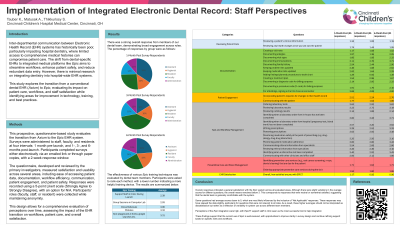Practice Management
131 - Implementation of an Integrated Electronic Dental Record: Staff Perspectives


Kameron Tauber, DDS
Dental Resident
Cincinnati Children’s Medical Center Hospital, Cincinnati, OH
Cincinnati Children's Hospital Medical Center
Cincinnati, Ohio, United States
Sarat Thikkurissy, DDS, MS, MA (he/him/his)
Professor
Cincinnati Children's Hospital Medical Center
Cincinnati Children's Hospital
Cincinnati, United States
AnnMarie Matusak, DDS, DDS
Program Director
Cincinnati Children's Hospital Medical Center
Cincinnati Children's Hospital Medical Center
Cincinnati, Ohio, United States
Scott Schwartz, DDS, MPH
Associate Professor
Cincinnati Children's Hospital Medical Center
Cincinnati Children's Hospital Medical Center
Cincinnati, Ohio, United States
Presenting Author(s)
Co-Author(s)
Research Mentor(s)
Program Director(s)
Purpose: Inter-departmental communication between Electronic Health Record (EHR) systems has historically been poor, particularly in hospital-based dentistry units where limited real-time access to comprehensive medical histories can compromise patient safety and care. Transitioning from dental-specific EHRs to integrated medical platforms, such as Epic (Madison, WI), aims to streamline workflows, enhance patient safety, and reduce redundant data entry. This study evaluated the transition from a dental EHR (Axium) to the Epic cloud-based platform in a tertiary pediatric hospital, focusing on patient care, workflows, staff satisfaction, and areas for improvement.
Methods: This IRB-exempt, prospective, questionnaire-based study collected data from auxiliary staff, faculty, and residents at four intervals: 1-month pre-launch and 1-, 3-, and 6-months post-launch. Surveys were distributed electronically or on paper, with a 2-week response window. Respondents rated questions on a 4-point Likert scale, with 1 being most favorable.
Results: A total of 125 surveys were completed, including 44 pre-launch and 81 post-launch. Participant roles included faculty (14–16%), residents (24–40%), administrative staff (11–19%), hygienists (14–19%), and dental assistants (16–34%). Support staff in clinics during the launch was rated as the most effective transition tool (1.73), while cloud-based self-administered modules were least effective (3.69). Ordering lab tests and documenting immunizations posed the greatest challenges (3.61/3.71). Overall, respondents expressed high satisfaction with the Epic system (0.90).
Conclusion: The transition to Epic was largely rated as favorable/highly favorable, with significant improvements in patient data review, documentation, and satisfaction. Epic support staff during the launch was instrumental in ensuring a successful transition.
Identify Supporting Agency and Grant Number:

.jpg)